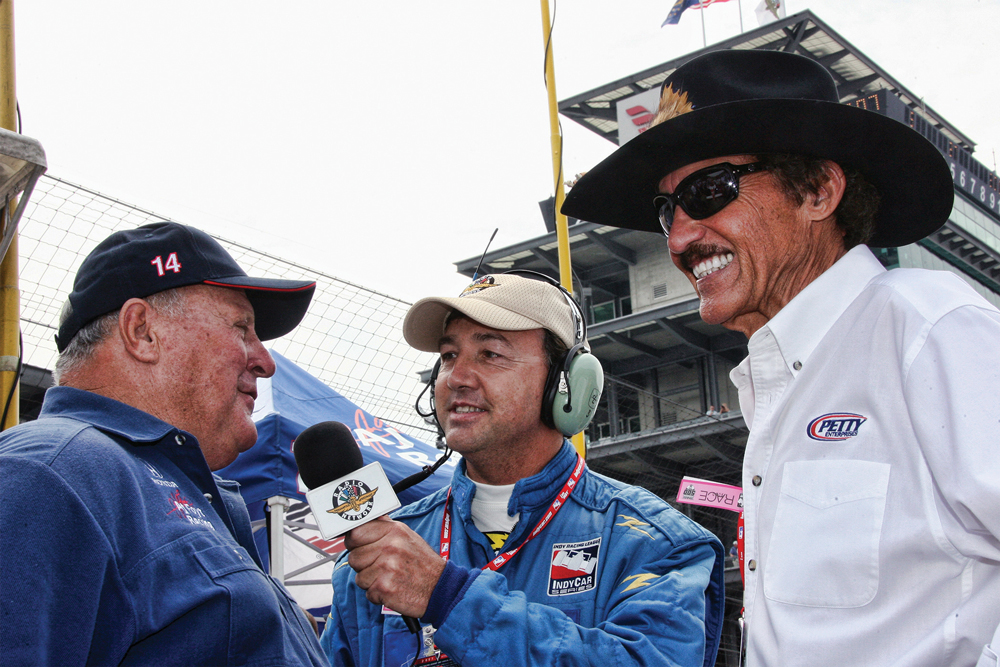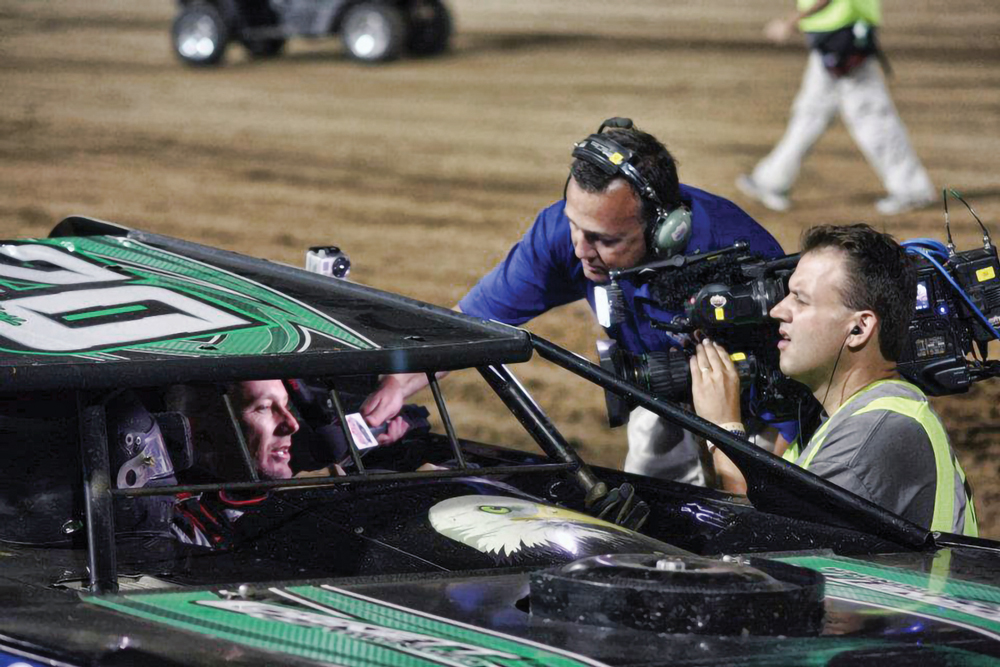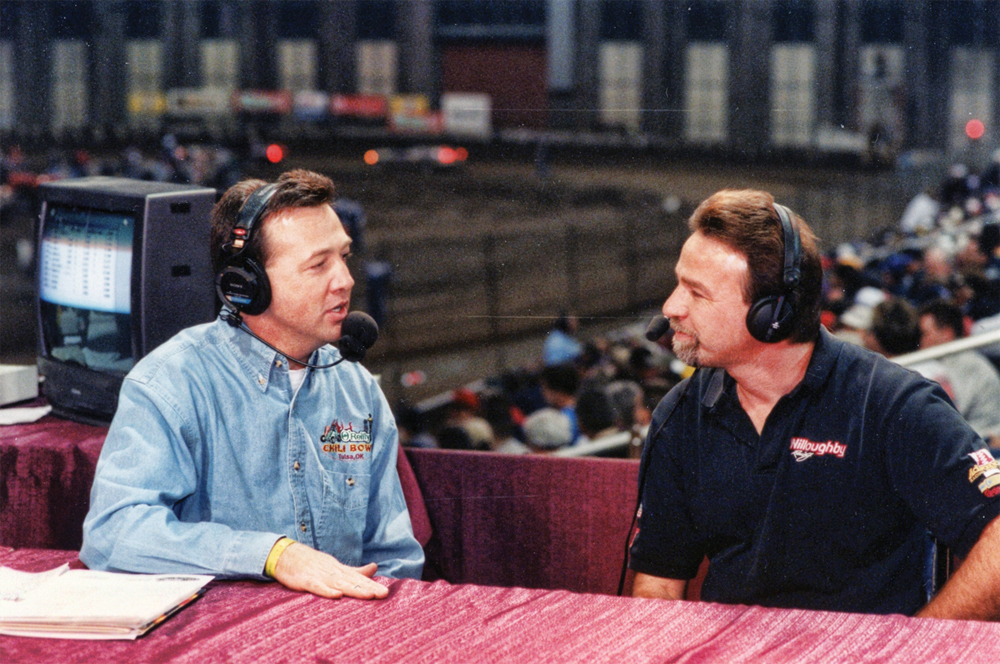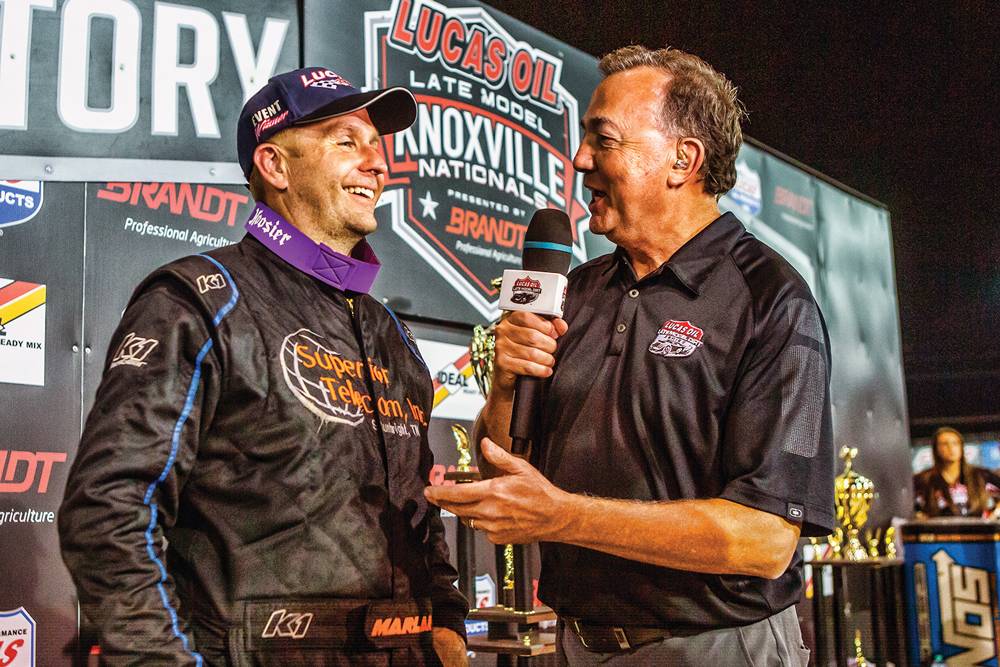Industry Insights: Dave Argabright

A fixture on pit road at countless televised race events, along with contributions in myriad racing publications—including this one—the Indiana native reflects on a Hall of Fame career in motorsports journalism, and hints at future opportunities to continue telling stories.
For the past 42 years, Dave Argabright has been among the country’s most influential and celebrated motorsports journalists. As a writer, his work has appeared in National Speed Sport News, SprintCar and Midget Magazine, Road & Track, Car and Driver, and right here in PRI Magazine. He’s also been seen and heard on Speed Channel, MAVTV, CBS Sports, ESPN, TNN, Versus, Must See Racing, and the Indianapolis 500 Radio Network. In addition, he’s the author of more than a dozen books on motor racing. His list of professional awards and honors is lengthy, and he’s earned every one of them.
Recently, Argabright made the decision to step back from day-to-day coverage of motor racing and spend more time writing books and tackling new projects. Given his decades of experience and always-insightful thoughts on the industry, we jumped at the chance for a sit-down to discuss, among other topics, how motorsports journalism has changed over the last half-century and where it stands today.
PRI: Motorsports journalist is not a career that they tell you about in high school. How did you get into this line of work?
Argabright: It was just a fortunate accident. I’d been out of high school for a few years, and I happened to meet the sports editor of our local newspaper. I mentioned that I wrote a little bit for my high school newspaper, and he said they needed someone to cover high school football and basketball. I thought I couldn’t write for a real newspaper; there’s no way. But then he said, “Well, we pay 15 bucks a story.” At that time, 15 bucks was a tank of gas, so away we went.
I covered stick-and-ball sports the first couple of years, but my passion was already auto racing. So I started lobbying to cover some races and some racing personalities. The newspaper was in Anderson, Indiana, and they have Anderson Speedway, which is a legendary short track. I kept selling them on the idea that we needed to cover the local track better. Through the newspaper, I was exposed to National Speed Sport News and began writing for them, and that’s where it all took off.
PRI: What was it about motorsports that attracted you?
Argabright: I’m not sure I really know other than the atmosphere of a great short track race, where it’s loud and exciting and people are shouting. That attracted me from the get-go. Then once I got a chance to get to know some of the people behind the scenes and some of the competitors, that captivated me from day one. I never had any interest in driving a race car or trying to work on a race car for a living. That didn’t appeal to me, but the idea of being able to tell some of the stories really drew me in. That was compelling to me.
PRI: If you had to go back through all the races you’ve ever been to, is there one that really stands out?
Argabright: I think it would have to be when I was 10 or 12 years old, and I went to the Little 500 sprint car race in my hometown of Anderson, Indiana, for the very first time. Because I was an impressionable young kid, that really was the moment that just truly set the hook for me for the rest of my life to love motorsports. As I said earlier, it was loud and colorful, and I had just never seen anything even remotely like all that. From that moment forward, the gears in my brain were turning and I was just fascinated.
PRI: What do you know now, as you are mature in your career, that you wish you knew when you started?
Argabright: I wish I could have been a little more patient and tried a little harder to see things from various points of view. I had a tendency, like everybody else, particularly when I was younger, to want to see things in a black-and-white way. I’ve learned as I go along to see less and less black and white and a whole lot more gray. Things are seldom as simple as we want them to be.

PRI: The follow-up is, what’s the best piece of advice, personal or professional, that you’ve ever received?
Argabright: I was blessed with a series of mentors, in and out of motorsports. They really had a profound impact on me and the person I grew to be. One of the things that stuck with me was about 30-some years ago, Richard Petty said, “The easiest thing in the world is being nice to people.” I never forgot that. That’s as good a piece of advice as I’ve ever heard because it’s true. It doesn’t cost extra. Just be nice. It doesn’t hurt. Then the second thing was from Chris Economaki, who drilled into me: Ask a question. Whether it’s television, print, or whatever, just ask a question. Ask a question that you think the reader would ask, or the viewer would ask if they had the opportunity. That was good advice.

PRI: How has motorsports journalism evolved over the years you’ve been involved?
Argabright: For me, the biggest change has been the timeframe in which we have to collect our thoughts, get them organized, and get the information presented to the reader. In the magazine world, we had several weeks to gather information, contemplate a story, and get it out to different sources. We could build our story, but also our views, and we could get various points of view. We had time to do that. I think the contemplative writing and reading experience was very, very different because things were in much greater detail, and the analysis was much more thorough.
But today, everything is compressed into such a tight timeframe. I think we’re missing that deep analysis and that deep view of a complex issue. We try to distill it down into something that can be read and fully understood in three minutes. Some topics, some elements, you can’t understand in three minutes.
PRI: Along those lines, do you think social media is a good or bad thing for the motorsports industry?
Argabright: It’s a little bit of both. Obviously, social media can help, whether you’re a track or a driver. If it can help you get information out to fans quickly and efficiently, then it’s great. But if it’s also a vehicle where people use your social media account to say nasty, mean, negative things about you or your track or your series or your family, then it’s not a good thing. But I don’t know how you have one without the other, because that’s sort of human nature.
I believe social media is going to be around for many years to come, but I do think we forget sometimes that it’s a relatively recent social experiment. When I read about an NFL player who has been dogged with controversy because of his political or social views, and he deletes his Twitter account and then says, “You know what? It’s the happiest I’ve been in five years. I feel like a giant weight has lifted off of my shoulders.” That’s pretty telling, and it may tell us a little bit about where everything’s going.
PRI: What is it that makes good news?
Argabright: I think that news—like everything else in media—has to be somewhat entertaining at its core. It has to be something the reader feels is important enough to invest their one minute, three minutes, 10 minutes in reading or watching that story.
PRI: As someone who’s made his living interviewing people, what do you think makes for a good interviewer?
Argabright: Obviously, a person needs to do their homework. They need to study the subject beforehand. They need to understand where they want the interview to go. But you also learn pretty quickly that you can’t get in somebody’s face and ask the difficult questions, nose-to-nose, because you learn pretty quickly that you lose people. So you learn how to be diplomatic and use a lot of tact. You build their trust to where they can understand that you’re not there with a hatchet, you’re not there to try to put them in a bad light. You’re just there to try to get their answers. It takes a lot of experience, I think, before somebody is really good at that.

PRI: Do you always have a specific goal in mind for an interview, or is it better to let it roll on and see where it goes?
Argabright: It’s pretty rare that there was something really specific that I wanted. Most of the time, my goal is to help the readers know and understand the person and the subject better. I think it’s better to let an interview roll on. I say that a person needs to be prepared, but I also think that it’s really important to listen to what somebody is telling you, because a lot of times they’ll bring up something that opens the door to go in a whole different direction. That might be the most fascinating part of the interview; something that you hadn’t even thought about beforehand. You have to organically see where it’s going to lead.
PRI: What do you think we can do to recruit and train the next generation of motorsports journalists?
Argabright: Bringing kids to the race track and introducing them to people and exposing them to the sport is the number-one thing we could do. But as far as attracting young journalists, that’s a tough one because the state of journalism across the board, not just in racing, is very, very challenging right now. The legendary people, back in the day, such as Jim Murray and Jimmy Breslin and people like that, were great print journalists, but it was never a lucrative endeavor for them. Print journalism is very, very challenged right now because the consumers have shifted to electronic news media, and nobody wants to pay for content. If no one is paying for content, you don’t have a lot to offer that young person who’s trying to get into journalism in terms of being able to make a decent living.
It’s great to be passionate. It’s great to dedicate yourself to a venture, but at the end of the day you’ve got to be able to put beans on the table. That’s really the bottom line. Unless the model changes where consumers become comfortable paying for content, whether that’s print, electronic, audio, video, whatever, it’s going to be challenging. I’m not going to lie. I’m deeply concerned about where we’re headed.
PRI: Are there any racing promoters who have really impressed you, and what did they do that really made an impact on you?
Argabright: Earl Baltes who built Eldora Speedway. I was privileged to write his autobiography with him. Earl was great because he was such a flamboyant, charismatic person. He epitomized what old school promoting could be, getting attention, creating a lot of buzz and excitement. Nobody could do that quite like he did in his day.
Then Ralph Capitani. He was the race director at Knoxville Raceway. He really helped propel the Knoxville Nationals into the modern era and make it the dynamo that it is now. I always admired how he was this great, wise, astute, patient person. In the midst of one of the biggest events and one of the most important tracks in the world, he had a knack for making people happy. He knew how to get a lot accomplished without putting people off, without making people mad at him.
Both those guys were just terrific in their own way.

PRI: What do you wish more racers understood about promoters and the challenges they face and what they do?
Argabright: I’ve said for a long time that every racer should have a few weeks in the promoter’s chair on Saturday night to really understand how a race track works and how hard it is. And every promoter needs to spend a few weeks with a race team all week long, and then on the weekends, and truly understand how their world works. Because I think way too much of the time, promoters and racers forget that they’re really on the same team, and they really need each other to thrive in order for it to be successful.
PRI: What legacy do you want to leave in motorsports journalism for those who follow?
Argabright: I would hope that we preserved the history and the stories of racing the best way we knew how. I think over the long haul, I’m glad we were able to produce the books that we did because, despite the shift away from print and different things that are happening, books are still pretty permanent. And the books that we produced are going to be on shelves for a really, really long time to come, and that’s a good thing.
PRI: Is there anything that I have not asked you that you want to talk about?
Argabright: I want to make it clear to people that even though I’m dialing back quite a bit, and even though I’ve ended some of my longtime monthly obligations, I’m not retiring. I’ve had a pretty ambitious workload for a lot of years. I don’t want to work quite that hard anymore, but I definitely want to stay engaged in the sport, and I still want to tell some stories. I’m excited to explore telling the stories in a different way, through video or podcasts or some of the newer technologies. It would be both interesting and challenging to see if I could continue to tell stories in a totally different way.
 MEMBERSHIP LOGIN
MEMBERSHIP LOGIN JOIN PRI
JOIN PRI


